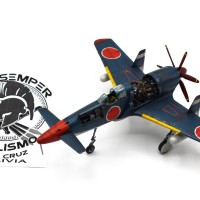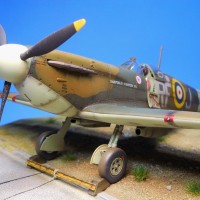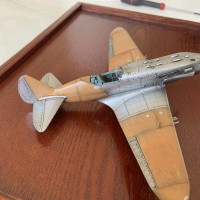Camouflage & Markings: Hawker Hurricane squadrons over France, 1939-1940, contd.
This article is part of a series:
NQ-G
No. 43 Squadron in Tangmere had converted from Hawker Furies to Hawker Hurricanes in early 1939.
No.43 Squadron spent the early months of the Second World War flying defensive patrols in the north of England and Scotland. On 3 February 1940, three of the squadron's Hurricanes based at RAF Acklington intercepted and shot down a Luftwaffe Heinkel He 111 bomber at Whitby. The formation was led by Flight Lieutenant Peter Townsend. It was the first German aircraft to fall on English soil in World War II (although it was not the first to be shot down in the United Kingdom, that having occurred in Scotland).
No. 43 didn't ever relocate to France but it did cover the Dunkirk retreat, operating from Tangmere.
OP-D L1934
In March 1938, No. 3 Squadron, based at Kenley, proudly became the second RAF fighter squadron to receive the Hawker Hurricane, following No. 111 at Northolt. The Hurricanes needed every inch of Kenley's grass runways to get airborne. Enthusiastic locals often hid in the bushes outside the airfield to watch these modern marvels barely clear the hedges on their takeoff runs!
L1934 was manufactured by Hawker at Brooklands in May 1939. It had all the typical attributes of the first production run: fabric wings, a two-blade propeller, an unarmored windscreen, a ring-and-bead gunsight, a venturi tube, ejector exhausts, and a ventral fin.
It was painted in a ‘B' pattern camouflage scheme with black and white undersides. It carried small A1 roundels on the fuselage, none on the lower wings, and just one same-size A1 roundel on the upper port wing.
At 14:00 on May 10, following the German invasion in the West, No. 3 Squadron left for Merville in France to support the British Expeditionary Force. It remained in France for only 10 days, claiming 60 German aircraft for the loss of 21 of its own.
GG-K L1768
No. 151 Squadron was reformed on August 4, 1936, at RAF North Weald. In December 1938, they received Hawker Hurricanes. Much of 1939 was spent training and integrating the new fighters into their operations.
The squadron had a brief spell in the defence of France. On May 17, they were ordered to Manston, Kent. From there, they conducted offensive patrols over the continent with forward bases in Abbeville or Vitry. These missions were successful, with 9 Junkers Ju 87s claimed destroyed on May 17, followed by 7 Bf 109s and a He 111 the next day. However, a few days later, the continued landings in France were deemed too risky, and the squadron returned to flying from Manston in support of the Dunkirk evacuation.
L1768 was produced by Hawker's Brooklands factory and taken on charge on January 19, 1939. It is presented here in its factory-fresh configuration, with ejector exhausts and a ventral fin, as well as an early type antenna mast, ring & bead gunsight, unarmored windscreen, fabric wings, and a two-blade propeller.
Typically for Brooklands production, it featured smaller Type B roundels on the fuselage and presumably no roundels on the wings. The squadron emblem was on the fin. There was a white L1768 serial on the lower port wing, which might have been repeated in black (not shown here) on the starboard wing.
L1621
No. 111 Squadron RAF, also known as “Treble One,” was the first squadron to be equipped with the Hawker Hurricane. In January 1938, this transition marked a quantum leap in the RAF's modernization efforts.
Throughout the first half of 1938, No. 111 Squadron focused on training, integrating the Hurricanes into their operations,a nd helping to iron out the initial quirks of the aircraft. This period allowed the pilots to become proficient with the new monoplane's capabilities and handling characteristics.
On February 10, 1938, Squadron Leader J.W. Gillan demonstrated the Hurricane's prowess by flying from Edinburgh to Northolt at an average speed of 408 mph, showcasing the aircraft's speed and performance. By July, the unit was declared fully operational with the Hurricanes. The squadron's readiness was demonstrated during various exercises and public events, including a notable appearance at the “Fête de l'Air” in Villacoublay, France.
L1621, representative of that period, belonged to the very first production block of the Hurricane. It had fabric wings, no ventral fin, two-blade propeller, kidney-style exhausts, ring-and-bead gunsight, early unarmoured windscreen, early antenna mast, a venturi tube under the windscreen.
The aircraft had silver undersides. Note the stylized read-and-white number "111" at the fuselage and a small squadron emblem on the fin.
Following the German invasion of France, No. 111 Squadron was moved to Northolt. On May 16, 1940, a flight from No. 111 Squadron joined a flight from No. 253 Squadron to form a joint unit. This unit was briefly deployed to France while the other half remained in Britain.
SD-A L2039
Squadron Leader Michael Victor McDonnell Clube was the commanding officer of No. 501 Squadron. The unit, also known as the “County of Gloucester” Squadron, was part of the Royal Auxiliary Air Force. It transitioned to the Hawker Hurricane in March 1939. In December 1939, they were stationed at RAF Tangmere, a key airfield in West Sussex.
On 2 December 1939, Sqn Ldr Clube was injured in an non-descript aircraft accident, flying the depicted aircraft.
On May 10, 1940, with the German invasion of France, No. 501 became part of the Advanced Air Striking Force (AASF) and moved to the continent. The unit operated from several airfields, including Bétheniville, Anglure, Le Mans, and Dinard. They saw extensive action, engaging in numerous dogfights with the Luftwaffe. Notably, Sgt. J.H. “Ginger” Lacey shot down three enemy aircraft in a single day, earning the Croix de Guerre. Following the fall of France, the squadron retreated through Saint Helier, Jersey, and returned to the UK. They came to play a key role in the Battle of Britain, becoming one of the highest-scoring RAF fighter squadrons.
L2039 was manufactured by Hawker Brooklands and taken on charge on 26th July 1939. The aircraft carried pre-war style roundels, black-and-white undersurfaces and a large Squadron Leader's pennant on the fin. Ejector exhausts and the ventral fin were improvements over the initial aircraft configuration: fabric wings, two-blade propeller, early-style antenna mast, unarmoured windscreen and ring & bead gunsight.
L2039 was struck off charge on September 14, 1940, after being involved in another incident with No. 73 Squadron.
LR-Q
LR-Q was another unserialled Hurricane of No. 56 Squadron operating from Noth Weald in mid-1939. No. 56 was one of the early adopters of the Hawker Hurricane and played a significant role during the early stages of World War II.
The aircraft has fabric wing, kindey-style exhausts and a venturi tube at the port side of the fuselage below the windscreen, early-style aerial, ring & bead gunsight. There is no ventral fin.
The aircraft featured small Type B roundels on the fuselage, but had no roundels on the wings, neither at the upper nor lower surfaces. Lower surfaces were painted in black & white with a split along the fuselage centerline.
No. 56 Squadron's introduction to the Second World War came on 6 September 1939, when the unit beceme the victims of a friendly-fire incident by No. 74 Squadron known as the Battle of Barking Creek. Two pilots of the squadron were shot down and one, P/O Montague Hulton-Harrop, was killed, becoming the RAF's first casualty in the defence of the UK.
Although primarily stationed in England, No. 56 Squadron was involved in operations over France by sending over flihts to France for short periods. They ended the campaign by covering the Dunkirk evacuation. Then the squadron moved on to play a crucial role in the Battle of Britain.
VY-X P3119
Squadron Leader David Francis William Atcherley, along with his twin brother Richard, had a distinguished career with the interwar RAF. Atcherley took command of No. 85 Squadron in November 1938. Under his leadership, the squadron transitioned from Gloster Gladiators to Hurricanes. The Hurricane was a significant upgrade, offering greater speed and firepower, a more complex power unit and a retractable undercarriage.
The P-3*** series aircraft were of the first production block at the Gloster Aircraft Company, Nov 1939 - April 1940. P3119 has factory-applied bright pre-war style roundels, typical of Gloster-built aircraft, on the fuselage and the mainplane undersurfaces. Glosters continued to use the pre-war roundel colours until well into 1940. The original Type A1 roundels on the upper mainplanes have been reduced in size and painted over using the duller wartime colours.
The orientation of the Squadron hexagon indicated the Flight - 'A' Flight's hexagons were point-up, while 'B'Flight's were flat side up. Suqron Leader'spennant under the cockpit. This aricraft also carried a small yellow-green gas detection patch on the port wingtip.
At the outbreak of World War II, No. 85 Squadron was part of the Air Component of the British Expeditionary Force (BEF). They moved to France in September 1939, operating from various airfields including Boos and Lille-Seclin1.
In December 1939, King George VI made a visit to France to inspect the British Expeditionary Force (BEF), whereupon he inspected the Squadron at Lille-Seclin. There are some known photos of VY*X from that visit.
After his time with No. 85 Squadron, Atcherley continued to serve in various capacities within the RAF. He was promoted and took on more senior roles, contributing to the RAF's efforts throughout the war.
P3119 was evacuated from France and continued during the Battle of Britain, flying with No. 151 Squadron where it shot down a He 111 on 30 August 1940.
LK-S L1628
Sqn Ldr Coope was a British Assistant Air Attache in Berlin between November 1935 and January 1939. Upon his return to Britain, Coope took command of No. 87 Squadron from 4th April 1939. No. 87 Squadron had been operating the Hurricanes since July 1938. At the outbreak of war, Coope led the squadron to France.
On 14th November 1939 Coope and P/O Richard Lindsay Glyde took off for a partol mission in Hurricanes L1628 and L1813, got lost in bad wether and had to execute forced-landings in poor weather at sandy beaches of De Panne in Belgium where they were interned. They escaped on the 24th and, with the help of the British Consulate, made their way back to France in civilian clothes and rejoined their unit on the 27th.
The Belgian authorities recovered the two aircraft, which were intact. Although their further fate is uncertain, it is believed that the interned Hurricanes were put into service with the Belgian Air Force.
Similarly to other Hurricanes of No. 87 Squadron, L1628 belonged to the first production block from Hawker Aircraft. I had fabric wings, two-blade propeller, ejector exhausts, early-style antenna mast, unarmoured windscreen and ring & bead gunsight. Of note is
the ventral fin. Black-and-white underside divided along the fuselage centerline.
P2575 "J"
P2575 depicted here was Manufactured by Gloster Aircraft Company and taken on charge in January 1940 with No. 73 Squadron, together with a complement of other factory-fresh Hurricanes ahead of that unit's deployment to France.
These were metal-wing Hurricanes with factory-mounted ventral fin and a two-speed de Havilland propeller, while still retaining the early style radio mast & antenna, unarmoured windscreen and ring & bead gunsight. The lower wings were painted in black & white, with the rest of the undersides in silver.
The initial four Hurricane squadrons, No. 1, No. 73, No. 85, and No. 87, were deployed to France in late 1939 and early 1940. They were tasked with providing air cover for the BEF and engaging German aircraft.
No. 73 squadron was based in Étain-Rouvres and engaged in regular patrols and interceptions typical of the Phoney War period. In contrast with the lack of hostitilties on the ground, they frequently encountered German aircraft, including Messerschmitt Bf 109s and various reconaissance aircraft. On April 23, 1940, Hurricanes from No. 73 Squadron, including P2575, were involved in a significant engagement where they were bounced by Bf 109s west of Merzig in Saarland, Germany. This resulted in several Hurricanes being damaged or destroyed, including a sister aircraft to this one, P2576 flown by Sergeant Cyril Norman Stanley Campbell. He had to bale out as the aircraft caught fire, and was admitted to hospital in Rombas with burns to arms and face and splinter wounds in his right leg.
P2575 survived the Battle of France and was withdrawn to the UK on June 17, 1940. It continued in the training role until 1944.













Thank for the images and the background information, Martin @editor. I love these pre- and early war schemes. Also, it's notable how these units did put up a fight in the battle of France. It is sometimes forgotten that the Germans suffered quite some losses on ground and in the air during that campaign and it's really only because of a few very lucky coincidences that they succeeded in such a swift way. They never envisioned it to be a blitzkrieg in the first place.
I certainly share you sentiment, @fxrob. For a variety of reasons, the air war during the Battle of France seems to be permanently overshadowed by the Battle of Britain, but as many of the quoted stories demonstrate, for the RAF the two battles were more of a continuity.
Thanks a lot for even more great profiles and the history behind it, Martin @editor
You're welcome!
A superb follow-up article, Martin! Excellent reference material!
Thanks for sharing!
Thank you, Spiros. I've learned a lot myself when researching for this material.